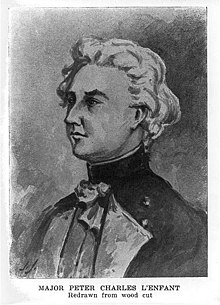 My wife and I were fortunate to pass through Washington D.C. during last summer. That being my first visit, as an architect naturally I could not help but admire the Beaux Arts vistas, symbolism, and majesty of the Washington Mall. But something bothered me – the centerline of the White House doesn’t line up with the Washington Monument.
My wife and I were fortunate to pass through Washington D.C. during last summer. That being my first visit, as an architect naturally I could not help but admire the Beaux Arts vistas, symbolism, and majesty of the Washington Mall. But something bothered me – the centerline of the White House doesn’t line up with the Washington Monument.
In a city so based on order and symmetry and strong axes, why is the Washington Monument not on axis?! It took me a bit of online sleuthing to find out why.

1791 L’Enfant Plan for the City of Washington. The Washington Mall (green) was the symbolic heart of the L’Enfant plan for the capital, connection Capitol Building, Washington Monument, and President’s House.
Beginnings: The Visionary 1791 L’Enfant Plan
The idea and design for the Mall and the Washington Monument’s location in the Mall originated in the 1791 L’Enfant Plan for the nation’s capital. That Plan, together with the 1902 McMillan Plan that updated and enlarged L’Enfant’s vision, remains today the historical blueprint for the capital and its centerpiece, the National Mall.
In L’Enfant’s vision, the Mall was intended to be a lively democratic public space in the heart of the capital and the nation. It would comprise a 400-foot wide “Grand Avenue” on an east-west axis extending from the Capitol westward to the Washington Monument near the banks of the Potomac River where it intersected the north-south White House axis.
Visualization: The 1836 Washington National Monument Society Competition
Plans to construct any palpable monument memorializing George Washington’s leadership languished for want of funding until 1833 when John Marshall, James Madison, and others formed the Washington National Monument Society to remedy this languor. By 1836 the society advertised for competitive architectural designs. The winning architect was Robert Mills, whose design called for a neoclassical plan with a nearly-flat-topped obelisk surrounded by a circular colonnade on which would stand a statue of Washington in a chariot.
Implementation
In an elaborate Fourth of July ceremony in 1848, the cornerstone was laid. Lack of funds, political discord, and ultimately the outbreak of Civil War in 1861 exacerbated the society’s difficulties with fund-raising efforts. When Lt. Col. Thomas L. Casey, Mills’ successor, resumed work on the project in 1876, he heavily altered the original design for the monument so that it resembled an unadorned Egyptian obelisk with a pointed pyramidion. The U.S. Army Corps of Engineers was charged with completing construction, and the monument was dedicated on February 21, 1885 and officially opened to the public on October 9, 1888.
Result: The Washington Monument as (non-) Focal Point
L’Enfant originally envisioned that the exact spot where the great north-south and east-west axes crossed was to be signified by a relatively modest equestrian statue of George Washington.
The Mill’s Proposal of 1836, however, re-envisioned this element, instead proposing the progenitor of the massive obelisk we see today. Thereafter in the actual implementation of the Monument’s construction the engineers responsible for it’s construction apparently observed that the formal nexus originally intended was too marshy and the soil there presumably not competent to support the weight of the massive structure proposed. And the resulting structure is indeed a massive structure, estimated to be in excess of 81,000 tons.
And so, with the conservatism of prudent engineers everywhere, the Monument was conveniently situated on higher ground some 300-feet east of the spot originally intended.
It should be noted that beyond a doubt, with today’s technological advances, locating the Monument at the spot originally intended would not have posed any intractable difficulties from a technical perspective. That said, given the era and the risks involved, one can hardly blame the 1848 engineering team for their conservatism.


















